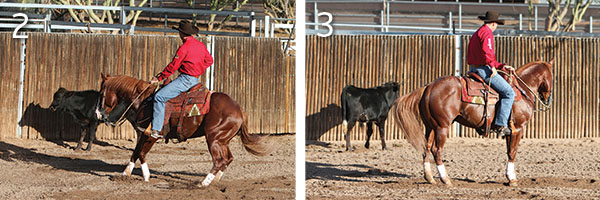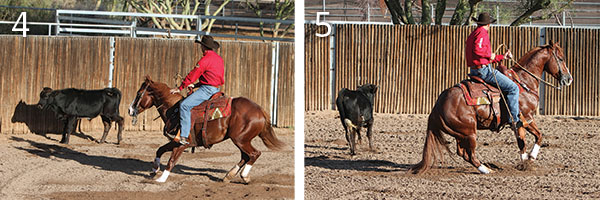To the untrained eye, the boxing portion of a boxing class or fence-work run might look like the horse is just going back and forth, keeping the cow at one end of the pen. But there’s much more to it than that. One of the most important parts of boxing is stopping with the cow—and I mean coming to a complete stop—before making another move. Here’s why.
When your horse stops underneath himself when working the cow, he’s naturally in an athletic position. He’s on his hocks, which means he’s able to move in a split second. It’s a “triple threat,” because he can change direction, go forward, or move backward. Additionally, a solid stop keeps your horse balanced so he doesn’t get heavy on the forehand or lean into the turn when he moves with the cow.
Here, I’ll cover scenarios that happen after I’ve stopped with the cow; they’ll convince you of the stopped position’s importance. I’ll also cover common mistakes and techniques for schooling to get back into position.
1. Here’s a perfect example of the “triple threat” that comes from stopping squarely with the cow, with my horse’s hindquarters nicely underneath him. Because he stopped well, my horse is loaded on his hocks, ready to push off. He can back up to get separation from the cow, relieving “pressure” so the cow doesn’t run away. He could go around the cow’s head to change direction. Or he can drive toward the cow’s hip to continue moving the cow in the same direction. In preparation for these swift moves, I have my hand up, I’ve taken the slack out of my reins, and my body is in an athletic positon.

2. This shows the lightness on my horse’s front end. He can turn to the left or right with an easy pivot. He’s sucked back, with his stifles flexed and his weight on his hind end. I facilitate this ready position by keeping my upper body perpendicular to the ground with my feet under me. My heels are down and away from my horse, so I don’t squeeze him and interfere with his instincts. My hand is down, placing slack in my reins so my horse can “cow up”—that is, use his natural instincts to work the cow rather than react to my cues.

3. After the action of the first two photos, it’s important to note that things do slow down—and my horse does, too. The cow is looking away; he’s stopped and not at all interested in my horse. Regardless, my horse is stopped and maintaining his position. He’s parallel to the cow, balanced, and attentive, even though there’s nothing going on. I’m relaxed and letting my horse rest in place so he doesn’t think he has to turn and face the cow every time. This brief “timeout” is just as important as the quick maneuvers. It prevents weak stops and leaning shoulders, as well as anticipation of turns.
4. Here’s when things can fall apart. You can see that my horse’s hind feet are out of the ground. He didn’t make a solid stop with the cow, so he’s on his front end. With his weight on the forehand, he won’t be light and accurate when he turns with the cow. It also allows my horse to anticipate the turn. To top it off, I’m just sitting there. My reins are loose, and I’m not helping my horse regroup. It’s time to make a few schooling turns to get back on track.

5. With these next steps, I’ll remind my horse of how he should stop. I’ve gone far enough past the cow to make it commit to changing directions, thanks to the fence stopping its forward momentum. I allow the cow to “release” from my horse (turn the other direction) while maintaining good forward momentum. A good stop requires acceleration and drive from behind so the horse can use himself properly, stay balanced and straight, and stop on his hind end. For my position, my rein hand is centered over my horse’s neck rather than pulling him toward the cow. I have contact with the bit so that if my horse starts to turn before he finishes his stop, I can correct him. Once he stops, I’ll back a few steps to reinforce that he should keep his weight on his hind end during the stop. It also helps remind him about staying straight and keeping his shoulders elevated. Then we can go back to working the cow.
Brad Barkemeyer, Scottsdale, Arizona, grew up on a ranch in Montana, which gave him an appreciation for versatile horses. He now trains open and amateur horses and coaches riders to success in AQHA, NRCHA, and NCHA competiton.






